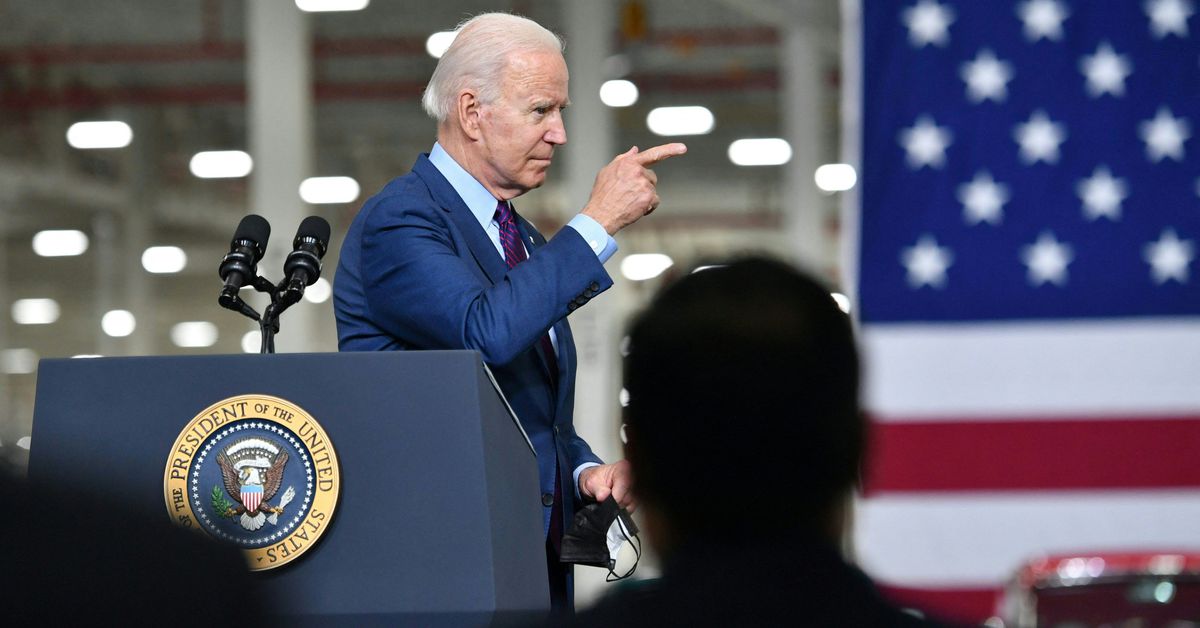
President Biden wants 50 percent of all new cars sold in the United States in 2030 to be all-electric, plug-in hybrid, or hydrogen-powered — a goal he will lay out in an executive order later today, according to senior administration officials. In addition, his administration will propose new fuel economy and emissions standards that will more or less erase the Trump administration’s rollback of the previous Obama-era rules covering cars made through 2025.
Biden will also sign an executive order that tasks the Environmental Protection Agency (EPA) and National Highway Traffic Safety Administration (NHTSA) to develop aggressive long-term rules to support his 2030 target, ones that include medium- and heavy-duty vehicles as well.
“When I say electric vehicles are the future, I’m not joking,” read a tweet from the President on Wednesday night.
This planned shift away from internal combustion engines is not as aggressive as the approaches that have been proposed or set in motion around the world. The European Union has proposed a de-facto ban on sales of new gas-powered passenger vehicles by 2035, though France has pushed back on the phaseout of hybrids, which still use fossil fuels. The United Kingdom wants to stop selling new combustion engine vehicles by 2030. China wants all new cars sold in 2035 to be hybrids at the very least, but is aiming for 50 percent to be plug-in hybrid, battery electric, or hydrogen-powered.
California, ever the leader on state-level environmental regulations, is also looking to ban new gas cars by 2035.
On the policy side, the proposed rule from the NHTSA will look to lock in average annual fuel economy increases of just under four percent, according to Reuters, and an ultimate fleet-wide average of around 52 miles per gallon for 2026 model-year vehicles. Under the Obama-era rule, automakers had to increase the average fuel economy of their fleets by five percent each year, with the goal of hitting a fleet average of 54 miles per gallon in the 2026 model-year cars. The Trump administration lowered this dramatically — during a climate crisis and a respiratory virus pandemic, no less — to yearly increases of just 1.5 percent and a target average of 40 miles per gallon. It did this despite the EPA previously determining that automakers were “over-complying” with the Obama-era rule.
The EPA, meanwhile, will propose a rule that requires emissions reductions that scale with the proposed fuel economy gains, as fuel consumption and tailpipe emissions are intrinsically linked. The two rule proposals will now go through a months-long public comment process before final rules are proposed and accepted.
The Biden administration’s new proposals have already won support from some major automakers, which will separately announce their own goals for electrifying their fleets later today. Representatives from General Motors, Ford, and Stellantis (the company that was created when Fiat Chrysler merged with France’s PSA group) will appear alongside Biden as he announces the executive orders and proposed rules, as will leaders of the United Auto Workers union.
That said, as was reported by Reuters, those three Detroit automakers are only committing to a “shared aspiration” of 40 to 50 percent of new car sales being plug-ins by 2030. They’re also asking for the government to pitch in big time, not just on incentives for new electric vehicles, but also “incentives to expand the electric vehicle manufacturing and supply chains in the United States,” according to a press release. The Biden administration has been pushing to support electric vehicle adoption in the bipartisan infrastructure bill, though some proposed investments (like for charging stations) have already been cut back in negotiations.
GM has said it wants to be carbon neutral by 2040 and that eliminating tailpipe emissions from its vehicles by 2035 is merely an “aspiration.” Ford, which has found early success with the Mustang Mach-E, has committed to going all-electric by 2030 — in Europe. The automaker plans to make 40 percent of its fleet all-electric by that year globally. Stellantis had previously said more than 40 percent of its North American sales in 2030 would be plug-in vehicles.
While the Detroit automakers have announced massive investments in electric vehicles, they were certainly not as united on policy during the Trump administration.
After the EPA and NHTSA moved to roll back the Obama-era standards under Trump, Ford (as well as Volkswagen, Honda, BMW, and Volvo) struck a deal with California to keep aiming at a relatively strict target. GM and what was still Fiat Chrysler at the time, meanwhile, actually joined the Trump administration’s fight in court over California’s right to set its own emissions standards. The automakers (along with Toyota) have maintained that they joined the court bid because they believed it should be up to the federal government to set these types of standards. But they have since abandoned that fight — GM just after the 2020 election, and Stellantis earlier this year. Meanwhile, Biden’s EPA has already moved to restore California’s emissions regulation authority.
All-electric vehicles currently only make up about two percent of total sales in the US, though they’ve jumped sharply in recent months as the new and used car markets have gotten red hot. More than 100,000 fully electric vehicles were sold in the US in the second quarter of 2021, according to Kelley Blue Book, driven in large part by the success of Tesla’s Model 3 sedan and Model Y SUV. But hybrid vehicle sales were up, too, with more than 250,000 sold — a 200-percent increase year over year.
"sold" - Google News
August 05, 2021 at 04:00PM
https://ift.tt/3jn7L1D
Biden wants half of new cars sold in 2030 to be hybrid or all-electric - The Verge
"sold" - Google News
https://ift.tt/3d9iyrC
https://ift.tt/3b37xGF
Bagikan Berita Ini














0 Response to "Biden wants half of new cars sold in 2030 to be hybrid or all-electric - The Verge"
Post a Comment